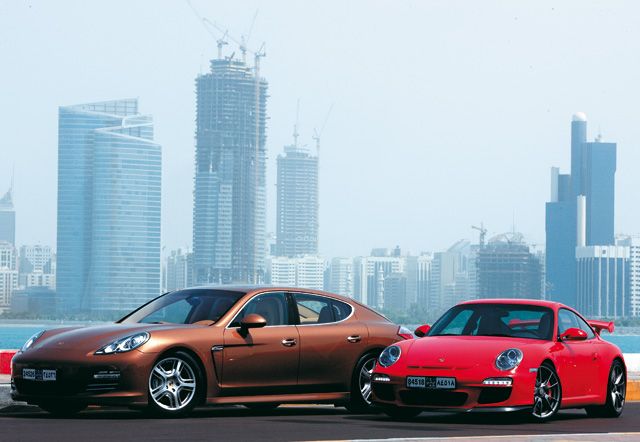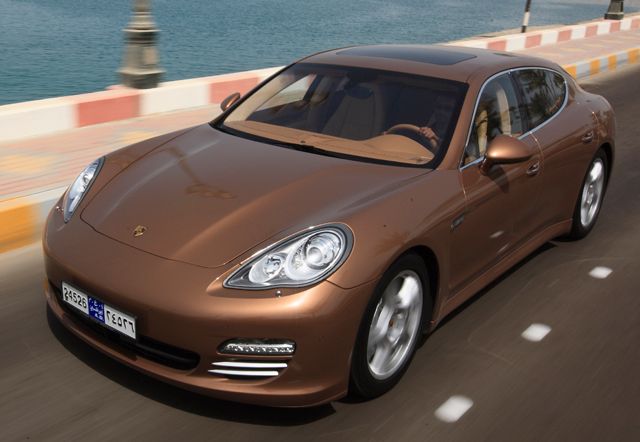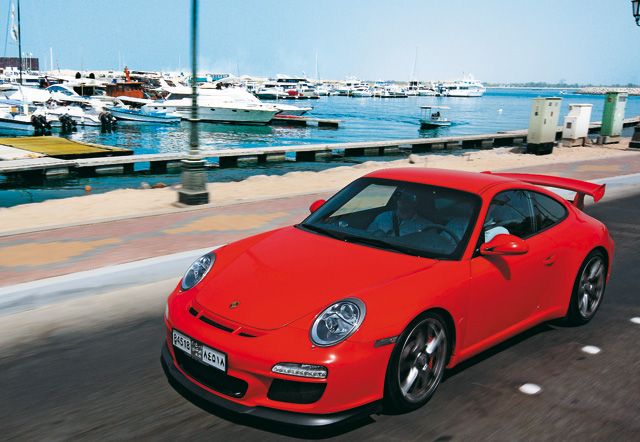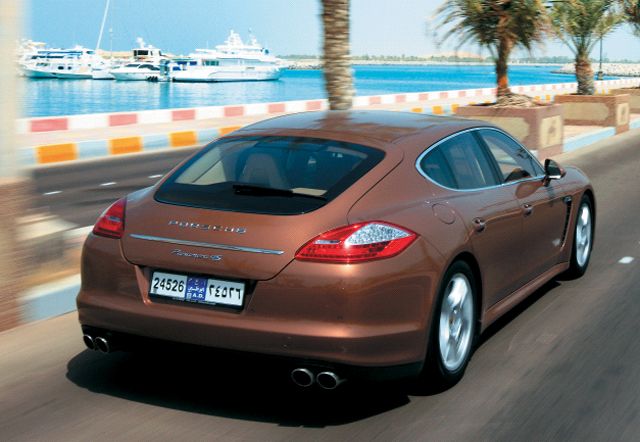Our idea of a great weekend is a bunch of fast cars and a photoshoot location far, far away, preferably taking in more than just arrow-straight blasts through the vastness of the UAE desert. So last Thursday, we piled into our latest long-terming Nissan Altima Coupé (more on that next week) and pointed it south on the E11 for an encounter with two of the most hotly anticipated Porsches.
It's not every day we go to Abu Dhabi, and when there is something newsworthy happening in the capital, we usually send the intern. As a result, we don't know the roads too well. We rolled into town in the middle of rush hour and started playing ‘find the Porsche dealership'.
Before we spotted the showroom, we eyed a bright red and heavily winged Porsche on Corniche Road. Could that be our GT3? Amit was instructed to put foot and get closer. Sure enough, on the side of the spoiler were etched the numbers three and eight. So we ran into one half of our German party purely by chance and, after miming greetings and introductions car-to-car, we signalled the GT3 to lead us to Ali & Sons.
The GT3 was stretching its legs on the way, while the bronze Panamera was waiting. It was going to be a good day.
Amit and the Panamera 4S
The 911 purists aren't an adventurous bunch. To keep them content, all Porsche needs to do is make every successive model faster and lighter than the one it replaces, and to heck with everything else. They don't care if their new sportscar looks exactly like the one their grandpa had in 1537, as long as it has a rollcage and a wing at the back. While they do like to let their hair down every once in a while with signal green decals and wheels, they mostly do not like change.
If you happen to be one of them, might I suggest you flip to page 30. Because what we're reviewing here is the Panamera, a four-door Porsche.
Right, only normal people left? Good. Let me make it clear at the outset: the Panamera is not a four-door-911. Expecting a family saloon to handle like a sportscar is akin to the logic of a Sumo wrestler filling in for a ballerina — it isn't going to work. Now that we've got that out of the way, let's start with the challenging bits.
The Panamera goes head-to-head with the likes of Maserati Quattroprote, Mercedes CLS 63 and the forthcoming Aston Martin Rapide. And when it comes to aesthetics, there isn't much to say. The Panamera looks like a squashed Cayenne, which is hardly a ravishing beauty to start with anyway. The 911-esque front is passable, but the back? Simians have better derrières. The Panamera is undoubtedly imposing in the metal: it's 53mm longer than the CLS 63 AMG and sits on a 66mm longer wheelbase. In other words, it's ruddy huge, so people will notice you everywhere you go. Some will even point and laugh but, for obvious reasons, you can't blame them. This isn't a car you'll buy for the way it looks.
So, it is a typical Porsche when it comes to aesthetics. That said, we were mobbed by digicam-wielding Japanese tourists in Abu Dhabi. But then, that's what Japanese tourists do.Inside, there aren't many surprises. You'll find more skin than on a nudist beach, more wood than in a rainforest and more buttons than on a BlackBerry. In true Porsche style the cabin isn't the most exciting either, but everything looks and feels like it will last for a thousand years.
When it comes to build quality and materials, this car punches way above its weight and thrashes everything in its price range. A similarly priced Audi RS6 looks like a cheap hatchback by comparison — the interior is that good.Naturally, the thing that you're probably most concerned about is whether the Panamera drives like a Porsche. It does, but not like a 911. It is poised and balanced, but it fails to disguise its mass on the move. The heavier Quattroporte shrugs its weight and flies, but in the Panamera you are always aware that you're driving a 1.8-tonne car.
On the flip side, the Panamera won't scrape its wing mirrors if you blast around a bend too fast. The amount of grip from the 19in rubbers is phenomenal. Even when the tyres do break traction, you get a smidgen of entertaining and easily controllable oversteer. You'll have to try very hard to mess things up in this car.
If you're a keen driver, you'd probably jab the sport plus button as soon as you step inside, like I did. In full attack mode, the ride height is lowered by 25mm and the gear changes are eye-poppingly quick, though markedly jerky. Not very luxury saloon-ish, that. However, the 400bhp 4.8-litre motor is fantastic. If you're really on it, you'll see 100kph in 4.8 seconds, and eventually smash the 280kph barrier. In faux-racer mode the ride quality is hardly ministerial. But still, it won't shake the fillings out of your teeth like a Quattroporte Sport GTS does.
So if you're slightly, er, mature — which you probably are if you're looking to buy a mega saloon — you can switch to ‘comfort' and waft. In old-person mode, things calm down quite a bit. Progress is seamless and you're not thrown out the front windscreen every time the twin-clutch PDK box changes gear. It's much more relaxing, but as an S Class rival, the Panamera is still some way off the mark.
It's an unabashedly driver-orientated car. For about 450K, you get a saloon that hits all the sweet spots. Almost. It's got massive presence, the cabin is sublime and the driving dynamics are up there. Plus, it's a Porsche, and in the world of badge worshippers, that alone is worth every fil you spend.
The Panamera 4S is undoubtedly one of the best sport saloons on the market today. But in the end, it comes across as a car designed to please Porschephiles. And I am not one of them.
Dejan and the 911 GT3
Rewind: as the red GT3 led us through downtown Abu Dhabi on the way to meet up with the Panamera, we had to dispatch a tunnel. Both windows immediately wound down in our Altima Coupé and the owner of the red 911 generously blasted it through, resonating the raw naturally-aspirated racket of a Porsche 3.8-litre flat-six. Acoustically, this car has more talent than Mozart.
I swear, I could even hear some of that air-cooled history in the new direct-injected, 435bhp lump. The pistons sounded as if they were wrestling each other, drawing blood, rather than working in unison and extracting every bit of performance available. A Porsche engine always sounds like this (well, maybe not the one in front of a Panamera driver), but a GT3 nearing 8,500rpm is like Thor having a really bad day: it's violent, it's scary… and so dangerously addictive.
The rawest Porsche of all — at least until the RS joins us here next March — is technically brilliant. The dry-sumped boxer six has an engine block and cylinder head made of aluminium, conrods are forged titanium, maximum power comes in at 7,600rpm and 430Nm of torque help out at 6,250rpm, which is quite high up, but all the more encouraging to keep playing with the six-speed manual. Also, the stats mean the new and bigger 3.8-litre — it's still not the biggest, a 1993 911 RS had the same capacity — outputs 114.6bhp per litre and allows 20 more horses than the outgoing GT3. Which is why it reaches 100kph in 4.1 seconds and only runs out at 312kph. Everything else is optimised too; it's 30mm lower than a standard Carrera, it's more efficient than the old version thanks to a variable intake system, its gearbox is exclusive with a shift-up light and 22 per cent shorter ratios, and it features the most dynamic version of Porsche's Stability Management.
A new limited-slip differential also takes care of the 911's mythical snap-oversteer by applying brake force at the rear should the driver lift off the throttle mid-bend. And despite improvements everywhere — including its more aerodynamic body — the new GT3 gains no extra kilos; it weighs in at 1,395kg as before.
Inside, it's a basic Carrera, but you can get red six-point harnesses and a half roll-cage, although even the cheapest option looks and feels rhino-proof. And it's a mind-blowing car to drive; steering is strangely lighter than on a Carrera S, but more intuitive, feeding back exactly what the front tyres are up to. That front end also never feels light or hesitant to turn in despite most of the weight being behind you. Traction on this rear-driver is fantastic, as you'd expect.
The 3.8-litre GT3 is blessed with the sweetest normally-aspirated engine I've ever experienced (the Ferrari F458 might change that, though) with a blissful power delivery that keeps the seatbelt biting into your hips at all times, as long as the right foot is keen.
The entire experience is magnified a million-fold thanks to a gear-change action that's the closest to perfection I've ever felt. The super-duty clutch makes your knee tremble after a while, but it's a more than fair trade-off for such satisfying gear shifts. Once the weighty but springy clutch bites about half way, you'll quickly need it again for second and the stubby lever immediately reaches the entry point for the next gear, after which you have to give it a firm push to hear and feel a good ol' mechanical clunk below.
The middle pedal is firm too, but the lightweight 380mm discs up front start doing their job after the very first millimetre of travel.
As initial experiences go, I can safely say it's love at first sight. But Abu Dhabi is much too congested and much too grid-like to extract anything close to the GT3's potential. Pretty soon, I'll meet up with my subject of lust again and give her the caning she so obviously lives for. But this much is clear; as far as Porsches go, all PDK or Tiptronic 911s may as well be recycled. The GT3 should be the only thing coming out of the Leipzig factory. And the RS, obviously.
Me? Well, I can't wait for my mid-life crisis.
(Panamera test car courtesy of Porsche Centre Abu Dhabi, Ali & Sons)















